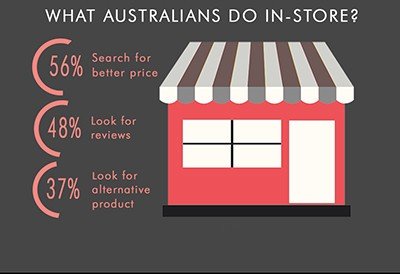
It was, for a long time, a widely accepted truth that whilst people might use phones to access the internet, they wouldn’t use them to buy things. Too small a screen; too hard to type; not secure enough; the list of reasons was as long as it was – so time has proved – wrong.
In this vein the latest global research from the IAB shows that for a large and growing number of consumers’ mobiles pay an increasingly central part in their shopping behaviours. Those behaviours are varied and show the multi-faceted role that mobiles play in shopping. And, interestingly, in many ways Australia and the wider APAC region leads the way.
The study highlights a number of key trends. Firstly, that for those already using mobiles to access the internet, the vast majority (75%) have also used their phone to buy something. Of those, over 70% of Australians are doing so at least once a month, with nearly a third doing so more than once a week. It seems that not only do people not mind using mobiles to buy products and services, they have ended up doing it pretty regularly.
In terms of what is driving these trends, it’s probably unsurprising that for many people convenience is the key, and more so in Australia than the global norm. Globally 16% of those using mobiles for purchases also claim that they do so because it is safer than using cash, which jumps to 21% in Australia, highlighting the role that mobile is also playing in offline retail.
So what should retailers and brands take from all of this?
First, that opportunities exist across the board. It’s probably no surprise that nearly half of those (43%) buying via mobiles globally have paid for an app, but perhaps more so that of those in APAC have used their phone to purchase clothes, shoes or other fashion items.
Secondly, that though the most popular destinations for mobile commerce are retailer apps or sites, 32% of mobile purchasers in APAC have used the sites or apps of specific brands, suggesting there is still room for direct brand-consumer relationships. And for those looking for a hint of what the future might hold for the rest of the world (and giving a clue as to why Facebook is so keen to promote the retail opportunities of Messenger and WhatsApp), the fact that over a third of those in Japan had used a messaging app is illuminating.
The final thing to consider, and something that has already been hinted at due to the fact that so many people feel safer paying with a mobile than with cash, is the interaction between smartphones and offline, an interaction which works both ways. For just as half of mobile shoppers in APAC have researched a purchase using their phone and then bought in a store, 42% have done the reverse: bought something on their phone having checked it out in-store.
So where next for mobile commerce? I’d suggest that a look at what phones have already changed will help us understand what they will change next.
Back in the days before smartphones had conquered the world, but when mobile phones were approaching ubiquitous status in many developed countries, I once heard someone observe that their biggest impact on society was that they had made it acceptable to be late. This came from the fact that, before everyone had a mobile, if you arrived late you might find that those you had intended to meet had left: mobiles removed this danger as it became possible to get an update on, for example, which bar or restaurant the evening had progressed to.
And what might have caused someone to be late? Perhaps forgetting one’s wallet or purse and having to go back for it. Fast forward ten years and the fear of having to return home to get one’s wallet is becoming as rare as not knowing which bar the party has moved to.
You order an Uber and get dropped off near the venue. Nip into a store and buy a gift using Apple Pay. Get a 20% credit on your dinner bill thanks to Amex Offers. And order a pizza to be waiting when you get home with Menulog.
All of this, without ever having to reach for the physical wallet that you forgot at the start of the night.
And so whilst much attention has rightly focussed on the rise of mobile wallets (an area, it has to be said, that American Express has taken a leading role, with its adoption of Apple Pay, Samsung Pay and Android Pay), it’s the way that many apps are removing the need to even think about payment, making mobile to offline commerce truly frictionless, that is likely to truly revolutionise the way we think about money for ever.
(Download the Infographic and Global MComm Report here.)